| کد مقاله | کد نشریه | سال انتشار | مقاله انگلیسی | نسخه تمام متن |
|---|---|---|---|---|
| 1988651 | 1540397 | 2006 | 14 صفحه PDF | دانلود رایگان |

The final process step of polyclonal human immunoglobulin G is formulation with agents such as sugars, polyols, amino acid and salts. Often the most stable formulations were empirically identified. Physicochemical methods, such as differential scanning calorimetry and dynamic light scattering, provide a deeper insight on the biophysical properties of such a protein solution. The combination of these methods proved to be sensitive enough to detect fine differences in the properties relevant for the development of stable protein solutions. The influence of additives, such as maltose and glycine in combination with water or low concentrations of salts, on human immunoglobulin preparations was analysed. Differential scanning calorimetry illustrated that 0.2 M glycine had better stabilising effects compared to 10% maltose. Dynamic light scattering and differential scanning calorimetry revealed that solutions preventing aggregation were not optimal in terms of thermodynamic stability. Aggregation was minimised with increasing ionic strength, shown by dynamic light scattering, whereas thermodynamic stability for heat sensitive parts of human immunoglobulin G, analysed with differential scanning calorimetry, was decreased.
Journal: Journal of Biochemical and Biophysical Methods - Volume 66, Issues 1–3, 31 March 2006, Pages 73–86